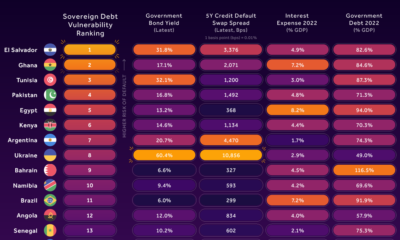Today, new innovations in tech are continuing to shape the consumer credit industry – and with U.S. consumer debt sitting at $13 trillion, these changes could play a role in impacting how consumers access credit both today and in the future.
The Modern Credit Landscape
Today’s infographic comes to us from Equifax, and it gives a snapshot of modern credit as well as a perspective on how new technologies such as trended and alternative data are changing the landscape. It’s the second part of our ongoing three-part series on credit:
Credit scores play a massive component of consumer life, and they are used to gauge creditworthiness for big purchases ranging from homes to launching a business. Interestingly, how this scoring works is not at all static – and new technology is being applied to increase accuracy as well as open credit up to more consumers throughout society.
Traditional Credit Scoring
The modern numeric credit score emerged in 1989, and it uses logistic regression to make informed decisions on a consumer’s creditworthiness. The scoring model is made up of five distinct categories: But this model does have its limitations. For example, traditional credit scores give a snapshot of credit rather than showing how the “big picture” of a person’s credit is changing. Further, current scores can also can be inhibited by a lack of data, resulting in an inaccurate representation of a person’s credit.
Tech to the Rescue
On a global basis, the data universe is doubling every two years – and this abundant new resource is revolutionizing consumer credit. Trended Data Instead of looking at a snapshot of a credit score, it’s possible to analyze the direction, velocity, tipping points, and magnitude of changes in a consumer’s credit history to get a bigger, more accurate picture. This is called trended data, and it can offer up to 20% improvement in predictive performance. Alternative Data Credit history is important, but there are increasingly other sources of data that can provide a view of a consumer’s creditworthiness. Alternative data taps into information on property ownership, wealth, how customers pay everyday bills, and other data sources to provide a more well-rounded picture. Other Tech Technology has given consumers unprecedented access to their credit data – and in the meantime, new science behind neural networks is being implemented to give even more sophisticated scoring capabilities.
on The good news is that the Federal Reserve, U.S. Treasury, and Federal Deposit Insurance Corporation are taking action to restore confidence and take the appropriate measures to help provide stability in the market. With this in mind, the above infographic from New York Life Investments looks at the factors that impact bonds, how different types of bonds have historically performed across market environments, and the current bond market volatility in a broader context.
Bond Market Returns
Bonds had a historic year in 2022, posting one of the worst returns ever recorded. As interest rates rose at the fastest pace in 40 years, it pushed bond prices lower due to their inverse relationship. In a rare year, bonds dropped 13%.
Source: FactSet, 01/02/2023.
Bond prices are only one part of a bond’s total return—the other looks at the income a bond provides. As interest rates have increased in the last year, it has driven higher bond yields in 2023.
Source: YCharts, 3/20/2023.
With this recent performance in mind, let’s look at some other key factors that impact the bond market.
Factors Impacting Bond Markets
Interest rates play a central role in bond market dynamics. This is because they affect a bond’s price. When rates are rising, existing bonds with lower rates are less valuable and prices decline. When rates are dropping, existing bonds with higher rates are more valuable and their prices rise. In March, the Federal Reserve raised rates 25 basis points to fall within the 4.75%-5.00% range, a level not seen since September 2007. Here are projections for where the federal funds rate is headed in 2023:
Federal Reserve Projection*: 5.1% Economist Projections**: 5.3%
*Based on median estimates in the March summary of quarterly economic projections.**Projections based on March 10-15 Bloomberg economist survey. Together, interest rates and the macroenvironment can have a positive or negative effect on bonds.
Positive
Here are three variables that may affect bond prices in a positive direction:
Lower Inflation: Reduces likelihood of interest rate hikes. Lower Interest Rates: When rates are falling, bond prices are typically higher. Recession: Can prompt a cut in interest rates, boosting bond prices.
Negative
On the other hand, here are variables that may negatively impact bond prices:
Higher Inflation: Can increase the likelihood of the Federal Reserve to raise interest rates. Rising Interest Rates: Interest rate hikes lead bond prices to fall. Weaker Fundamentals: When a bond’s credit risk gets worse, its price can drop. Credit risk indicates the chance of a default, the risk of a bond issuer not making interest payments within a given time period.
Bonds have been impacted by these negative factors since inflation started rising in March 2021.
Fixed Income Opportunities
Below, we show the types of bonds that have had the best performance during rising rates and recessions.
Source: Derek Horstmeyer, George Mason University 12/3/2022. As we can see, U.S. ultrashort bonds performed the best during rising rates. Mortgage bonds outperformed during recessions, averaging 11.4% returns, but with higher volatility. U.S. long-term bonds had 7.7% average returns, the best across all market conditions. In fact, they were also a close second during recessions. When rates are rising, ultrashort bonds allow investors to capture higher rates when they mature, often with lower historical volatility.
A Closer Look at Bond Market Volatility
While bond market volatility has jumped this year, current dislocations may provide investment opportunities. Bond dislocations allow investors to buy at lower prices, factoring in that the fundamental quality of the bond remains strong. With this in mind, here are two areas of the bond market that may provide opportunities for investors:
Investment-Grade Corporate Bonds: Higher credit quality makes them potentially less vulnerable to increasing interest rates. Intermediate Bonds (2-10 Years): Allow investors to lock in higher rates.
Both types of bonds focus on quality and capturing higher yields when faced with challenging market conditions.
Finding the Upside
Much of the volatility seen in the banking sector was due to banks buying bonds during the pandemic—or even earlier—at a time when interest rates were historically low. Since then, rates have climbed considerably. Should rates moderate or stop increasing, this may present better market conditions for bonds. In this way, today’s steep discount in bond markets may present an attractive opportunity for price appreciation. At the same time, investors can potentially lock in strong yields as inflation may subside in the coming years ahead. Learn more about bond investing strategies with New York Life Investments.



































